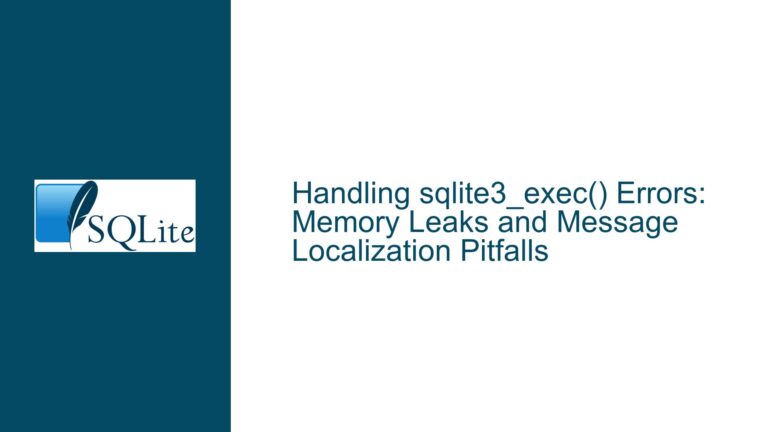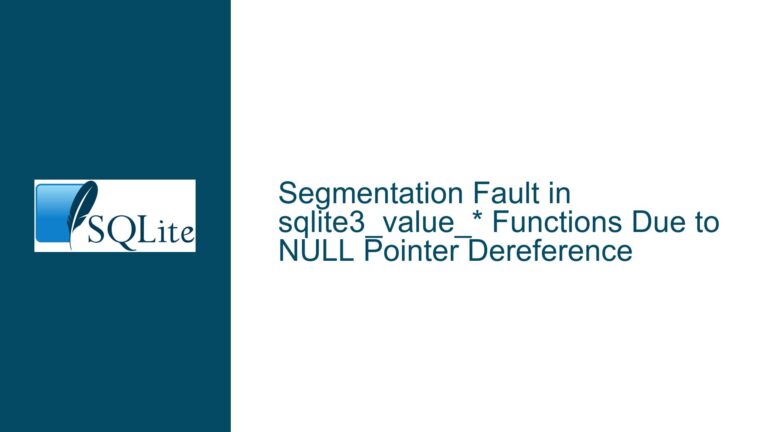Addressing Code Coverage Gaps When Embedding SQLite in Applications
Understanding Code Coverage Discrepancies in Embedded SQLite Implementations
Code coverage metrics serve as a critical indicator of test suite effectiveness, especially when working with embedded databases like SQLite. While SQLite’s own test suite achieves 100% function and condition coverage, applications embedding SQLite often observe significantly lower metrics. For example, a project embedding SQLite 3.36 reported 71% function coverage and 42% condition/decision coverage, while a Python wrapper achieved 62% line coverage. These discrepancies arise from differences in testing objectives, scope, and methodology.
SQLite’s internal testing employs a 590:1 test-to-code ratio, validating every public API function, internal subroutine, and edge case. In contrast, applications using SQLite typically focus on testing their own logic rather than SQLite itself. This indirect testing approach leaves gaps in coverage for SQLite functions, conditions, and code paths that are not explicitly exercised by application-level workflows. For instance, a data access layer might use SQLite’s JSON1 extension for ETL processes but omit tests for geometric functions or virtual table mechanisms.
The distinction between public API coverage and internal function coverage further complicates metrics. A project reporting 71% function coverage may include both SQLite’s exported functions (e.g., sqlite3_prepare_v2, sqlite3_exec) and internal utilities (e.g., sqlite3VdbeExec, sqlite3BtreeInsert). The latter are rarely targeted by application tests unless they directly impact observed behavior. Similarly, condition coverage measures the percentage of Boolean expressions evaluated to both true and false during testing. A 42% condition coverage implies that over half of SQLite’s internal decision points remain untested in the application context, increasing the risk of undetected bugs in edge cases.
These gaps are not inherently problematic—applications do not need to test SQLite itself—but they highlight opportunities to improve integration testing. For example, a Python wrapper that achieves 62% line coverage by testing corner cases (e.g., zero-length column names, embedded nulls in strings) demonstrates how targeted testing can validate SQLite’s behavior in application-specific scenarios. The key is to align coverage goals with actual usage patterns while acknowledging the impracticality of replicating SQLite’s own exhaustive testing.
Root Causes of Incomplete SQLite Code Coverage in Application Tests
Limited Utilization of SQLite Features
Most applications use a subset of SQLite’s capabilities. A project leveraging JSON1 and common SQL constructs (e.g., joins, subqueries) will naturally leave functions related to full-text search, R-Tree modules, or user-defined collations untested. This selective usage directly impacts function coverage metrics. For example, the sqlite3_rtree_geometry_callback function will show as uncovered if the application never implements spatial queries.
Indirect Testing Through Abstraction Layers
Applications often interact with SQLite via higher-level abstractions like ORMs or data access layers. While these layers validate business logic, they may not exercise low-level SQLite behaviors. Consider a data access layer that serializes objects to BLOBs: it might never invoke sqlite3_bind_text64 with the SQLITE_UTF16 encoding, leaving that code path untested. Similarly, transaction management via BEGIN IMMEDIATE or SAVEPOINT might be abstracted away, omitting tests for SQLite’s locking mechanisms.
Version-Specific Code Paths
Embedding an older SQLite version (e.g., 3.36) introduces coverage gaps for fixes and features added in later releases. For instance, SQLite 3.37 introduced the sqlite3_error_offset API for syntax error localization, while 3.38 added support for STRICT tables. Applications using outdated versions cannot test these code paths, even if newer features align with their use cases.
Overreliance on "Happy Path" Scenarios
Application tests often prioritize common workflows over error handling. SQLite functions like sqlite3_interrupt (to cancel long-running queries) or sqlite3_snapshot_open (for transaction control) may remain uncovered if tests do not simulate cancellation or concurrency scenarios. Similarly, condition coverage suffers when tests omit boundary cases, such as database files exceeding size limits or queries with deeply nested expressions.
Tooling Limitations
Coverage tools like BullsEye measure executed lines, functions, and conditions but do not account for environmental factors. For example, SQLite’s SQLITE_OMIT_* compile-time options exclude entire code sections from compilation. If the application’s build configuration omits features like FTS5 or statistics, those functions will never appear in coverage reports, skewing metrics.
Strategies for Enhancing SQLite Coverage in Integration Testing Environments
Map Application Features to SQLite Dependencies
Create a matrix linking application capabilities to the underlying SQLite functions and extensions they rely on. For example:
- JSON Data Handling:
sqlite3_json_init,sqlite3_json_*functions,JSON_EXTRACTSQL operator. - Concurrency:
sqlite3_snapshot_open,sqlite3_wal_checkpoint_v2. - Custom Functions:
sqlite3_create_function_v2,sqlite3_value_text.
This mapping identifies critical code paths requiring targeted tests. Tools like gcov or LLVM’s source-based coverage can highlight uncovered functions tied to these features.
Implement Boundary and Error Case Testing
Design tests that force SQLite into edge scenarios:
- Zero-Length Inputs: Pass empty strings to
sqlite3_bind_text, null BLOBs tosqlite3_bind_zeroblob. - Resource Exhaustion: Simulate
SQLITE_FULL(disk full) orSQLITE_TOOBIG(string exceedingSQLITE_LIMIT_LENGTH). - Concurrency Conflicts: Use multiple threads to trigger
SQLITE_BUSYand validate retry logic.
These tests improve condition coverage by evaluating both branches of SQLite’s internal decision points.
Upgrade SQLite and Align with Active Development
Migrate to recent SQLite versions (e.g., 3.45+) to access improved testing harnesses and bug fixes. Use the sqlite3_unittest function (available in amalgamation builds) to run SQLite’s internal tests within the application environment. This validates whether the build configuration or platform introduces unexpected failures.
Instrument SQLite with Custom Assertions
Embed debug hooks to validate assumptions during application tests:
sqlite3_config(SQLITE_CONFIG_LOG, my_log_callback, NULL);
sqlite3_db_config(db, SQLITE_DBCONFIG_ENABLE_TRIGGER, 1, &previous_value);
Log unexpected states, such as unresolved symbols in virtual tables or unclosed statements, to identify untested code paths.
Combine Direct and Indirect Testing
- Direct API Tests: Write unit tests for SQLite functions critical to the application, even if they’re invoked indirectly. For example, explicitly test
sqlite3_serializeandsqlite3_deserializeif the application uses in-memory databases. - Integration Tests: Validate end-to-end workflows while monitoring coverage. If a query using
WINDOWfunctions does not appear in coverage reports, add tests that exercise frame specifications and partitioning.
Leverage SQLite’s Test Suite as a Guide
Adapt SQLite’s internal tests to application needs. For instance, the fuzzcheck test harness can generate pathological SQL inputs to stress-test query parsers. Modify these tests to run against the application’s schema and queries.
Analyze Coverage with Context-Aware Tools
Use tools that differentiate between application code and embedded dependencies. BullsEye’s exclusion filters can ignore untested SQLite features (e.g., FTS3), while custom scripts can flag critical uncovered functions (e.g., sqlite3_backup_finish in backup/restore workflows).
Prioritize Security-Critical Code Paths
Focus coverage efforts on functions handling untrusted input:
- SQL Injection Mitigation: Ensure tests cover
sqlite3_prepare_v2(notsqlite3_exec) to validate prepared statement usage. - Memory Management: Test error paths in
sqlite3_malloc,sqlite3_reallocto prevent leaks in OOM scenarios.
By aligning coverage goals with risk areas, teams can optimize testing efforts without pursuing unrealistic 100% metrics.
This guide provides a comprehensive framework for diagnosing and addressing code coverage gaps in SQLite-dependent applications, balancing pragmatic testing with the realities of embedded database integration.






